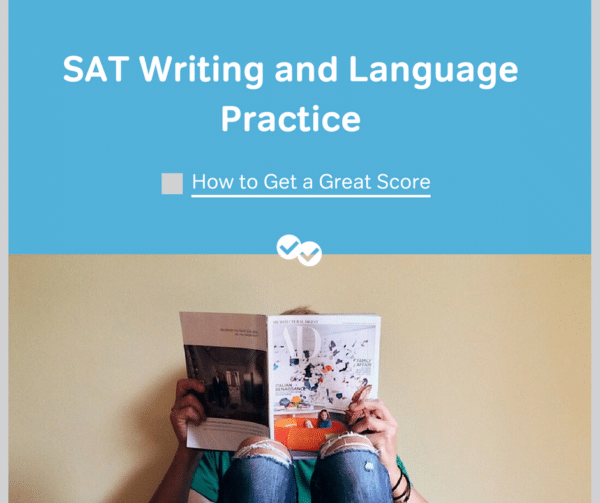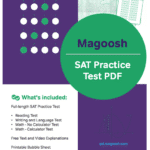
It may come as a big surprise that getting a great score on the SAT Writing and Language section has a lot in common with Kylie Jenner’s Instagram feed. Don’t believe me? For example, at first glance, both Kylie and SAT Writing might be intimidating (granted, for totally different reasons), but actually, they rely on patterns. Lots and lots of patterns.
Writers have identified patterns in Kylie’s selfie poses (there are 11 she uses the most, in case you were wondering). Similarly, there are a limited number of question types that the SAT Writing and Language section will present you with on test day.

That’s great news for you, because it means that you can a) practice/mock Kylie’s selfie game until you master it and b) do enough SAT writing and language practice until you master that. And then you can celebrate, because you’ve basically won life.
How to do it? Read on!
SAT Writing Practice: The Basics
- Figure out what you’re doing. Do you think Kylie just woke up one morning and won Instagram? No. She’s posted more than 5,000 times, people! Similarly, you can’t just walk into the test room and expect all the grammar you’ve studied (or not studied) for the past decade to magically come back to you. Start early with a “diagnostic” SAT practice test, to figure out where your strengths and weaknesses are in the Writing and Language section.
- Learn the format. You probably won’t put the exact same story on both your Snapchat and Instagram. Same thing’s true of SAT Writing and Language. There are aspects of this exam that are particular to this exam and this exam only. For example, reading the context is important. Embracing the “NO CHANGE” option can also be helpful. (There will be two to four “NO CHANGE” answers per passage!) And always, always answer every question—there’s no penalty for wrong answers! Practice will really help you master this one.
- Target your areas for improvement. True for both SAT Writing and Language practice and how to achieve the perfect lip look. Trouble with grammar? There’s help for that (and then some more help for that). Figure out what’s going wrong, and then—yep—do some SAT practice questions.
SAT Writing Practice: The Next Level
Okay, so you’ve gotten the ball rolling. But what do you do if you want to push your score up even higher? There are a few strategies you can use to take things to the next level.
- Take regular practice tests. Have I stressed how important these are? We’ve worked with thousands upon thousands of students here at Magoosh, and you know what we’ve seen? Students taking more practice tests do better on the exam. I know that might seem obvious…but think about it. In order to take 10 practice tests, you need to be organized. You need to set aside time, preferably once a week, preferably on a Saturday morning, to keep putting what you’ve studied during the week into practice. For SAT Writing, cramming just isn’t going to cut it.
- Make sure you know your commonly confused words. We confuse them all the time in everyday life, but it’s helpful to know the right vocab for test day. You never know what question will be the difference between the score you have and the score you want.
- Guess even more strategically. I know, I know—you already know about guessing. However, to really get the most out of this strategy, you should guess strategically. What that means is eliminating obviously wrong answers and then guessing the same letter every time (unless it’s one you’ve already eliminated). You can keep a roster: “I’ll always choose A unless I know A is wrong, then I’ll always choose B,” or other letters of your choice. This will significantly boost your statistical chances of getting this strategy to gain you points.
- Master timing. It’s not uncommon for students to feel time pressure on the SAT Writing and Language section. And yes, practice will help with this—but in this case, a specific type of SAT Writing practice will help the most.
Gather SAT Writing and Language practice problems (you’ll need a lot!). Divide them into sets of 10. Do the first set of 10 while timing yourself, then record your time at the top of the sheet. As you study, keep returning to these practice problems, shaving 5 or 10 seconds off your time and completing the set within those limits. Repeat until you can answer a question in an average of 45 seconds. There are more specific guidelines in this post—just make sure you adapt them to the SAT. Voila!
SAT Writing Practice: Mastery
And what should you do if you’ve almost reached total Instagram stardom—err I mean…that perfect SAT score—and just can’t get those last few points? I can’t really help you with the Instagram thing anymore, but there are some things you can do for a top score.
- Individualize your practice with an error log. If you’re scoring above 700, you may find it difficult to spot patterns of error in your SAT Writing practice. You may only miss one verb question, or one question about idioms, or one question about noun phrases…and it can be really hard to know how to improve. To combat this problem, keep a notebook in which you write down all the questions you miss, as well as their answers and how to get to those right answers. You may just start to spot some patterns—but even if you don’t, you’ll know how to address problems like these if you see them on test day.
- Take full practice sections as well as full practice tests. Yes, full-length SAT practice tests are a huge key to success. But on the other hand, it’s also important to have a sense of the pacing of a full-length SAT Writing and Language section. So while they shouldn’t replace your weekly practice tests, 35-minute practice in a particular section is a (time-friendly) way to help bring up your score. Not sure how to make this work in your schedule? Here are some awesome SAT study schedules to help you out.
- Study what you’re doing right as well as what you’re missing. Counterintuitive, I know. But students who are scoring particularly high have the tendency to focus on those last few points to the detriment of what they’ve already learned! Keep practicing what you’re good at, so you don’t get rusty as you bring your score up as high as possible.
#nofilter: SAT Writing Practice
Here it is, your moment of truth! The questions below are just a brief taster of SAT Writing and Language practice—it’s not a full passage. Remember, you can get even more SAT practice questions in the new SAT practice test PDF!
Choose the option that best answers the question.
[1]
Lately, a small but 1 annoying group of scholars, writers, and students have been questioning William Shakespeare’s place in the literary pantheon. For several hundred years, Shakespeare has been the undisputed master of English literature. Finally, his super-human status has turned against him. Now, people are beginning to ask whether an uneducated man raised by illiterate parents could truly have written these great plays. 2 These skeptics, known as “Oxfordians,” believe that William Shakespeare of Stratford-Upon-Avon, the figure to whom history has ascribed the plays, was not actually a writer, but the stand-in for an anonymous playwright. A wide variety of possible “true authors” have been proposed.
[2]
Much of the argument revolves around the lack of records surrounding William Shakespeare of Stratford. There are no records from the Stratford Grammar School, so his earliest education is undocumented. Additionally, no personal letters from Shakespeare remain. The only examples of his writing are six signatures that appear sloppy. His parents signed their names with an “X.” So did his daughters. 3 Despite all of this evidence suggesting that Shakespeare may have been illiterate.
SAT Writing and Language Practice Question 1
The writer wants to convey an attitude of respectful disagreement. Which choice best accomplishes this goal?
A. NO CHANGE
B. pestiferous
C. outspoken
D. irritating
(answer below)
SAT Writing and Language Practice Question 2
These skeptics, known as “Oxfordians,” believe that
A. NO CHANGE
B. These skeptics, known as, “Oxfordians,” believe that
C. These skeptics known as “Oxfordians,” believe that
D. These skeptics, known as “Oxfordians” believe that
(answer below)
SAT Writing and Language Practice Question 3
Despite all of this evidence suggesting
A. NO CHANGE
B. In contrast, all of this evidence suggesting
C. Therefore, all of this evidence suggesting
D. Taken together, all of this evidence suggests
(answer below)
SAT Writing Answers and Explanations
1. The best answer is (C). Although each of these words is fine in certain circumstances and the writer may believe all of them to be accurate, only “outspoken” conveys an appropriately scholarly tone. “Annoying,” (A) and “irritating” (D) are not respectful or scholarly terms. (B) pestiferous is far too formal and stiff. You are not expected to know this word–it’s a fancy way of saying irritating–but are supposed to be able to spot that it is far too formal for the SAT.
2. The best answer is (A). The phrase “known as ‘Oxfordians’” is an appositive phrase, so it must be surrounded by commas, as in (A). Answer choice (B) incorrectly places a comma between “as” and “Oxfordians.” This incorrectly mimics the use of commas before direct quotes; these quotation marks are not being used to indicate a direct quote. Answer choices (B) and (C) both leave off one of the commas which must surround the phrase.
3. The best answer is (D). This sentence sums up all of the previous sentences, so the transition should express agreement. Answer choices (A) and (B) both indicate that the sentence which follows will be in opposition to the previous sentences, which is not the case. Answer choice (C) correctly indicates that this sentence agrees with the previous sentences, but the word “therefore” is not used to introduce this kind of simple summary.
A Final Word
At the end of the day, the very best advice I can give you? Cut yourself some slack. If you only get, say, 15 million followers as opposed to Kylie’s 100 million, that’s still a big win! (Looking at you, Logan Paul.) And the same thing goes if you get a 790 on SAT Writing and Language—or a 700, or a 650—and it’s a significant improvement for you, that’s awesome and should be celebrated! So do all the SAT Writing and Language practice that you can (not forgetting about SAT Reading Practice and SAT Math Practice!), learn from what you’ve done, and then walk into the test room with confidence.
After all, that’s what it’s all about!







Leave a Reply